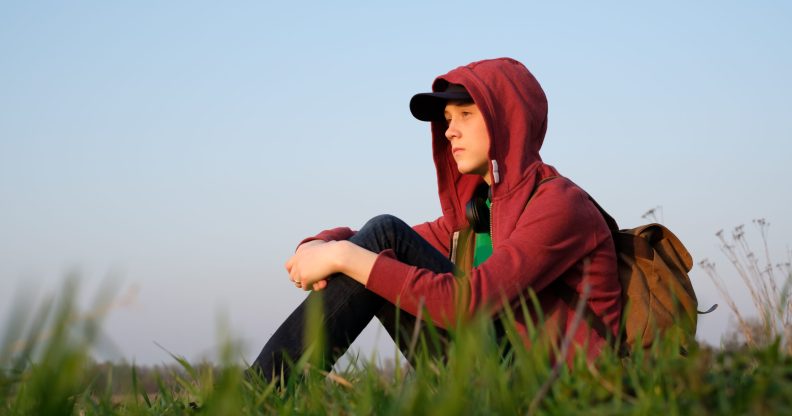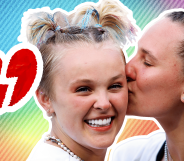Young trans men share brutal accounts of conversion therapy camps, where they were abused and forced to carry heavy rocks

A teenage boy. (Envato/ivankmit)
A teenage boy. (Envato/ivankmit)
For years now, secretive online networks of anti-trans parents have been forming on both sides of the Atlantic, looking for conversion therapy proponents who are “gender critical”.
The parents hope that these therapists will refuse to affirm a child’s own sense of their gender identity, and somehow convince their children that they are not trans.
While so-called “gay conversion therapy” – a harmful and discredited practice that attempts to convince or force a gay, lesbian or bisexual person into believing that they are heterosexual – has been in the British news recently while the Tory-led government considers banning the practice, conversion therapy for trans youth is less often talked about.
This changed when, in June, JK Rowling liked a tweet from a Canadian anti-trans organisation called We The Females, opposing a proposed law in Canada that would ban conversion therapy for LGBT+ youth, including trans kids.
Like other anti-trans organisations, We The Females propose that trans youth should be subjected to “gender-critical therapy”, to deter or prevent them from transitioning. Gender-critical feminists often claim that affirming therapists railroad youth.
However, affirming therapists accept the gender identity of their patients regardless of the outcome being cis, trans or non-binary. For gender critical therapists, the only result they will accept is cis, suggesting where attempts to railroad youth into a particular gender identity actually occurs.
Three young trans men speak out about horrific conversion therapy attempts.
A considerable number of young lesbian and gay people have come forward describing their experiences in secular (non-religious) conversion therapy programs. Twenty-year old TikTok user Merry produced a series of videos describing “How to Survive Conversion Therapy”, as a lesbian. She outlines how a conversion therapist will latch on to anything negative in your childhood as the reason why a person is gay and will attempt to make them straight by focusing on that event.
There are far fewer transgender people speaking out publicly about their experiences in conversion therapy as teens, and much of the “gender critical” focus has been on young trans men. I interviewed three; Dan, 19, Austin* (name has been changed to protect identity), 18, and Jayden, 25, who had been subjected to it as teens and are now young adults.
What the three young trans men were subjected to broadly falls in line with what leading “gender critical” therapists recommend: isolate them, cut them off from support, don’t use their preferred name or pronouns, deny their identity, try to make them accept and love being female, and attack the “delusion”.
It is worth noting that there is no clinical evidence to support the efficacy of such therapy, but numerous peer reviewed studies show trans adults subjected to conversion therapy as youth have a much higher risk of suicide attempts.
Conversion therapists misgender and deadname trans patients.
One common theme running through the three young trans men’s stories was that conversion therapists would never use their preferred name or pronouns.
In Jayden’s case, this went on for years, from the time he was 16 years old until he stopped seeing the therapist when he was 23. As is the case with gay conversion therapy, they looked for anything they could blame for being transgender. Jayden’s therapist blamed it on his parents’ divorce when he was three.
For Dan’s therapist it was blaming his autism.
Austin’s therapist latched on to his adoption as a baby as the reason they believed he was trans.
You’re just saying this because you think it makes it easier to pick up women.
Jayden, who was seeing a non-affirming therapist on an outpatient basis, noted she never wanted to talk about his gender identity, and never would acknowledge it. When he did try to raise the issue, the therapist shut him down, saying: “Your birth gender is female so you’re a female.”
She also blamed it on his sexual orientation: “You’re just saying this because you think it makes it easier to pick up women.” She never acknowledged nor explored the possibility that Jayden’s anxiety and depression could be caused by untreated gender dysphoria. Eventually he stopped bringing it up, but not before his mental health deteriorated further.
Trans teens sent to ‘wilderness programmes’ by their parents.
After coming out as trans, Dan and Austin were both sent to “wilderness programmes”, which typically involve the use of traditional therapy techniques mixed with group therapy out in a wilderness setting. Both were then sent to inpatient facilities for “troubled youth”, even though both were average to well above average students and not having trouble with drugs, alcohol, or the law.
During their time in the wilderness program, they were forced to march long distances (up to 16 km per day) with backpacks full of rocks and have “therapy” sessions twice a week.
Dan estimated that half his peers in the wilderness programme, as well as at the boarding school for “troubled youth” he was then sent to in Utah, were LGBT+ kids who had been sent there for simply being LGBT+. The same techniques used on him were also used on the lesbian girls, based on the decades old conversion therapy dogma that some unknown trauma makes you LGBT+. “It feels like [they’re] running for-profit concentration camps for queers,” he told me.
It feels like [they’re] running for-profit concentration camps for queers.
Therapists required that staff and other students to not use their correct name or pronouns. Austin was told: “Going by different pronouns isn’t allowed here” after his first group session. His therapist in the wilderness programme told him he was “insecure because you’re fat”, and, “You’re claiming to be trans because you like girls.”
During individual therapy sessions therapists would challenge Dan and Austin to prove that they’re trans. “How do you know?” they asked Austin.
When Dan tried to answer this same question, it was always insufficient. “That doesn’t make sense. Can you give me more concrete evidence?” He required Dan to read anti-LGBT+ activist Ryan T Anderson’s anti-transgender book, When Harry Became Sally. Anderson is a fellow with the right-wing religious Heritage Foundation organisation.
Dan described the purpose of the therapy as: “The goal was to convince me that I’m not trans, but to make me think it was my own idea.” Therapists tried to convince him that being a girl, and cisgender was so much easier and better. “You are so much more beautiful as a girl. Look at the long hair that you have, don’t you like that? You can’t have that as a boy. It’s so much easier being a girl.”
The goal was to convince me that I’m not trans.
Of the three, Dan attempted the most resistance techniques. This included playing dumb to run out the clock on sessions, giving long rambling non-answers, and claiming that his tampon was about to leak when things got too mentally dangerous in order to escape to the bathroom. He understood that they were trying to “slowly worm their way into my head”, in order to “get you to believe you’re not trans”.
Privileges were withheld if Dan wasn’t cooperative enough. He told me that they stopped giving him food he was capable of eating as punishment for being found wearing a binder that had been smuggled in, and claims that when he started, he was 125 lbs, and only 87 lbs when he left. No one is ever “cured”; he said, they “leave when they turn 18 or their parents won’t pay for it anymore”.
In the end, none of them stopped being transgender, and they still have their trans masculine identities. Conversely, all of them admitted that conversion therapy experiences left them traumatised and emotionally scarred.
While therapy should be patient centred, Jayden stated he had: “Never felt so unheard and disrespected” as when he spent years being told who he was, what he should think, and how he should feel about his gender and sexual orientation.

